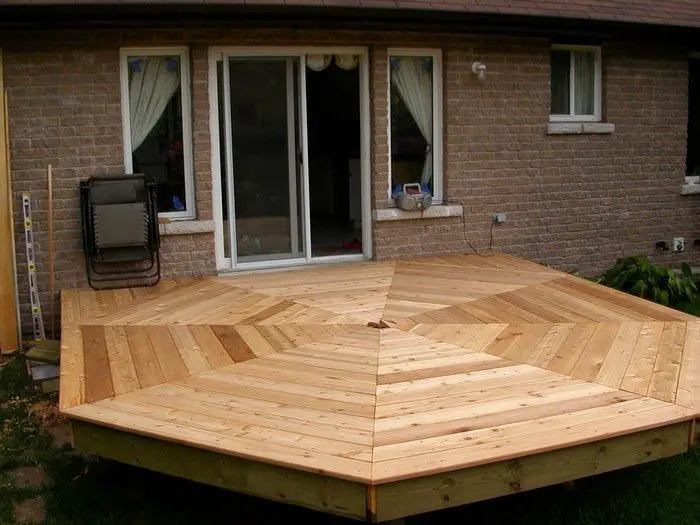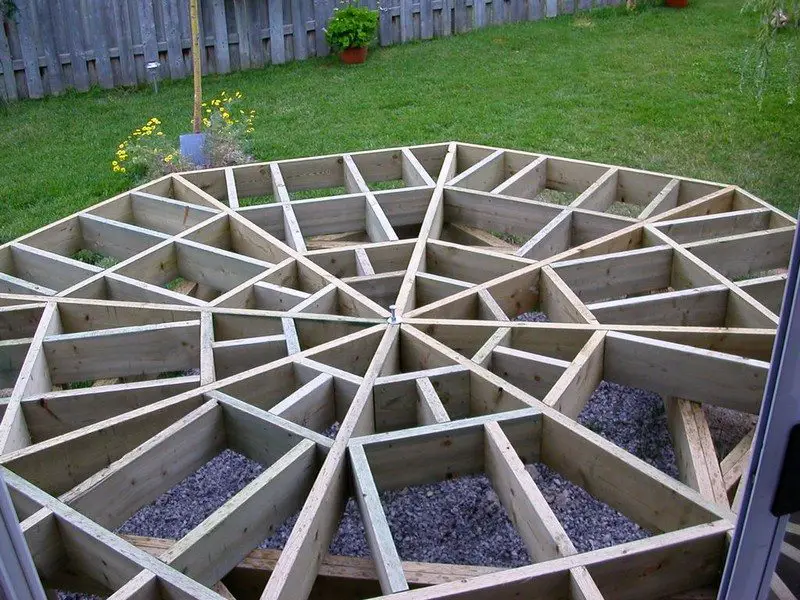
The cross joists: They are perpendicular to the end joists and are set at 16-inch centres. Notice that the joists are clamped at the centre.
This matrix of Joists, End Joists and Cross joints is extremely strong. Can you see that the last one I was about to install ends the task of installing the joists for the octagonal deck? All joists are secured with octagonal deck screws.

Installing the cedar octagonal deck: Start at the outer edge of the octagonal deck and work inwardly to the centre. The first row of decking overhangs the end joists by 1-1/2 inches.
Each piece of octagonal deck planking is fastened between adjacent main joists. Use octagonal deck screws, alternately driving the screws either to the front edge or the bottom edge of the plank in a zig zag pattern.
DO NOT screw down the ends of the planking at this time, keep the joints tight. Proceed around the periphery, with no spacing between planks. From time to time you will have to rip a board to keep the progression even. xKeep the scrap, it will fit an inner circle. (Note upper left of picture!)

The centre post clamping bolt: As you get closer to the centre of the octagonal deck, you will need to insert some scrap joisting to provide a surface to mount the decking.
Additionally, since the deck planking is firmly holding the joisting together, we have the opportunity to modify the centre post clamping screw to assure that the final pieces of decking can be fastened in the centre, without interference.
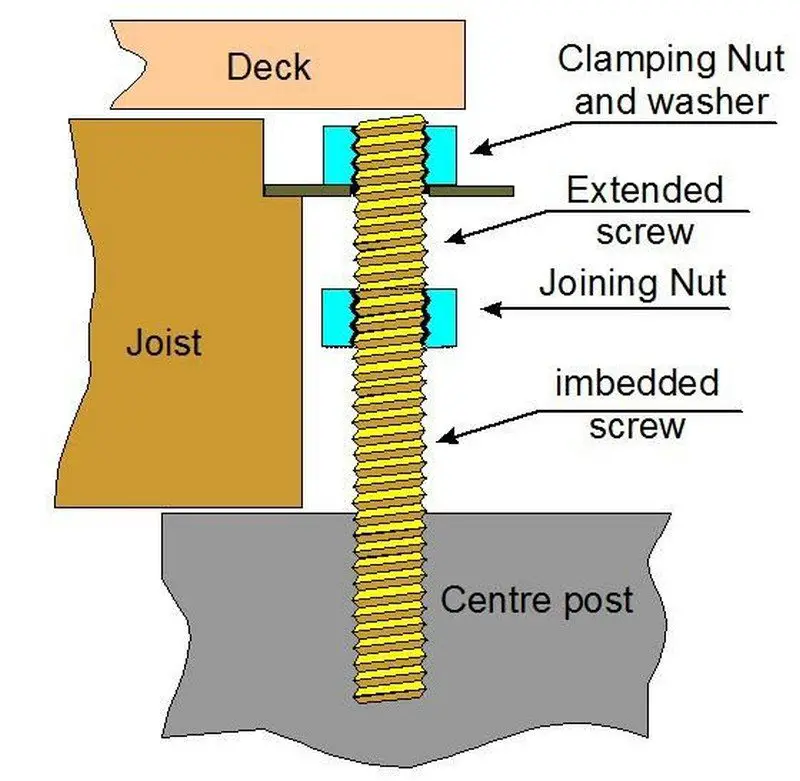
Clamping bolt clearance: To get the clamping screw and nut below the bottom of the octagonal deck surface, we need to chisel out the edges of the main joists around the clamping screw and nut to accommodate the big washer.
In Fact, at this point I installed a second smaller washer between the clamping nut and the original large washer to reinforce the larger washer.
Follow the image here and cut deep enough to accommodate screw and washer(s), and wide enough to JUST accept the largest washer. Mark the excess bolt length above the clamping nut, disassemble the nut and washer structure and then hacksaw the bolt to length. You will probably have to try this a couple of times to get it right.
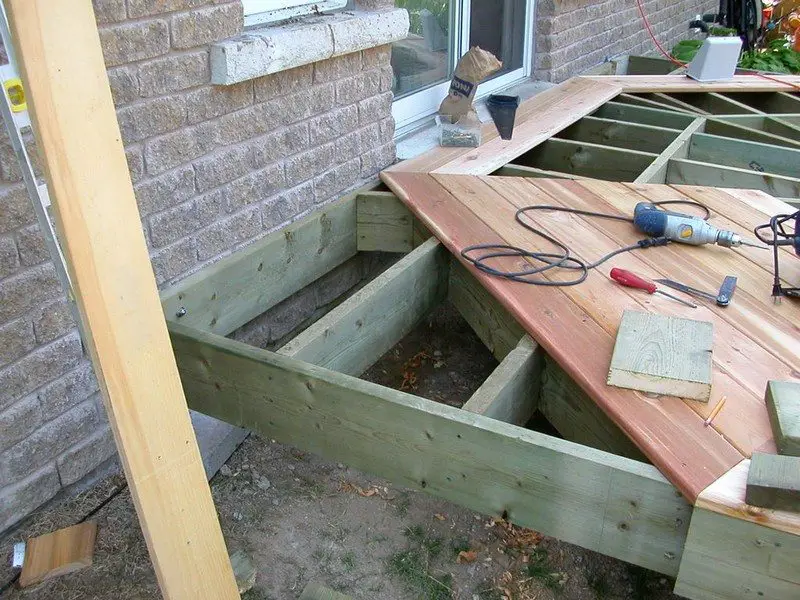
One of several mods: The connection of the octagonal deck to the house, required a small alteration in the plan.
Keep the octagon shape, but octagonal deck the space between the wall and the deck and make it obvious. Here is the framing between the deck and house.
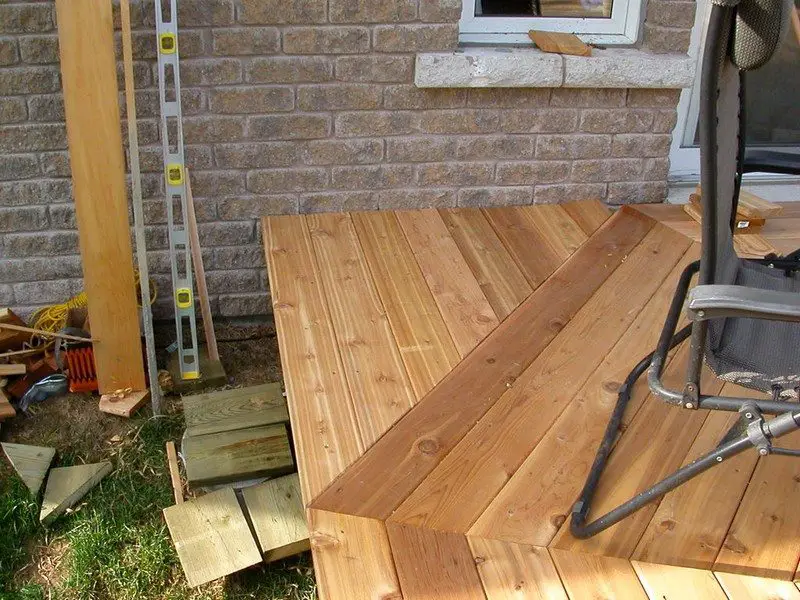
Between house and deck: Here is the decking between the octagon and the house wall.
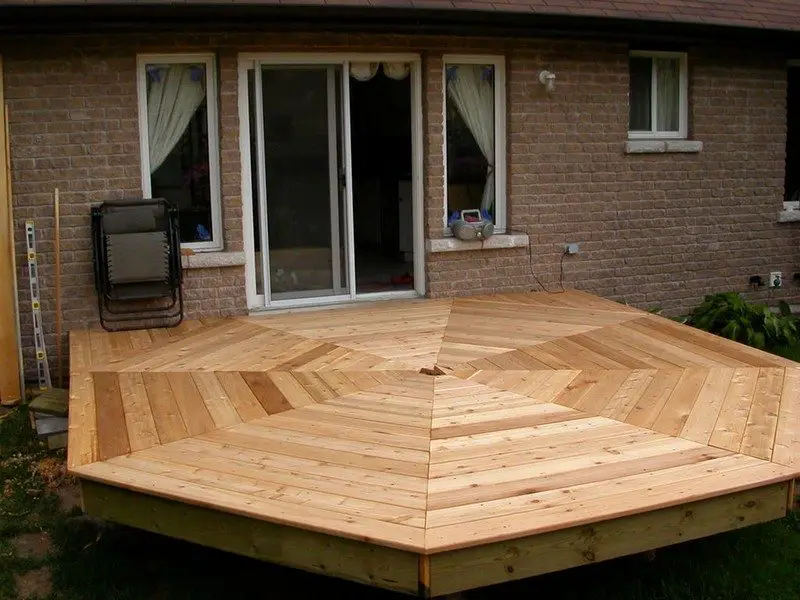
Decking complete… sort of: The deck looks great but my skills with the saw left rather wavy lines along the planking over the main joists. So my answer was to cover the joints with an inlay of cedar decking. Two reasons for this:
- Wavy lines
- Inlays clearly define the triangular segments of the octagon.
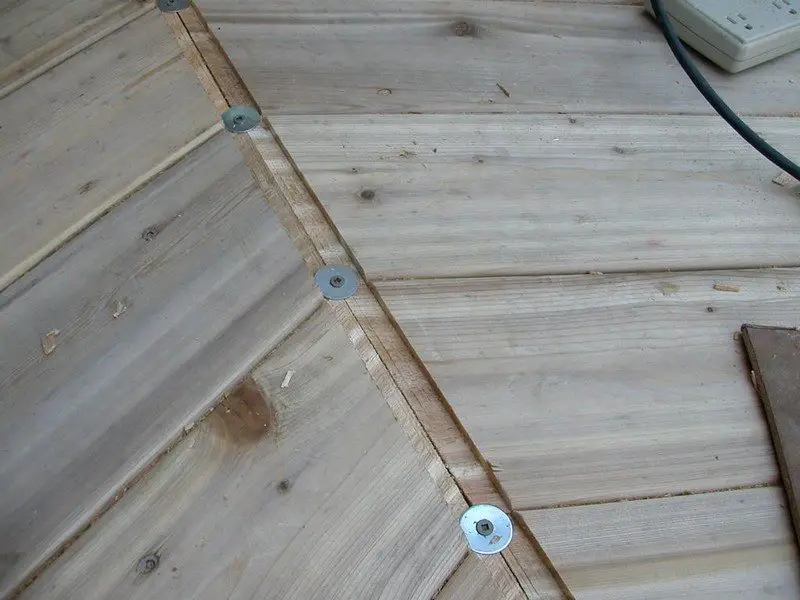
Second mod… inlays: To do the inlay,
- Rip a 6 foot piece of cedar decking about 3/8 inches thick.
- Using the 7-1/4 inch saw to cut the channel straddling the saw joins along the main joists to about 1/4 inch depth.
- Fasten all joints in the channel with a deck screw and washer
- Use contractor’s glue (waterproof) to glue the ripped strips into the channel.
- Use a hand plane to bring the level of the inlay to the deck surface. Sanding takes too much time.
(Sounds like “all ya gotta do is blah blah blah”) Let’s start…

The power saw as a router: Using the ripped piece of decking mentioned above, straddle the saw join with the cedar strip so that it is centred above the join. Draw a line along the right edge of the strip. See red dotted line in the diagram.
Measure your power saw edge guide. What is the measurement to the saw tooth closest to the edge guide? It should typically be about 1-1/4 inch. See yellow rectangle in the diagram.
Use a piece of scrap wood no thicker than 1/4 inch and tack the scrap wood onto the deck to the right of the drawn line a distance equal to the measurement of the guide to saw blade, and parallel to that line. See the brown rectangle in the diagram.
Make a cut from the vertice of the join to the centre of the deck – that’s 1/8″. Put the cedar strip between the scrap wood guide and the saw. Make another cut. That’s a total of 1/2″ channel. You got it!
Proceed until you get close to the line on the left of the saw join. Insert the strip, or make another cut. BE CAREFUL. MEASURE TWICE, CUT ONCE. PLEASE TRY ON A SCRAP OF WOOD BEFORE DOING THIS! When finished, clean out the uncut pieces with a wood chisel.
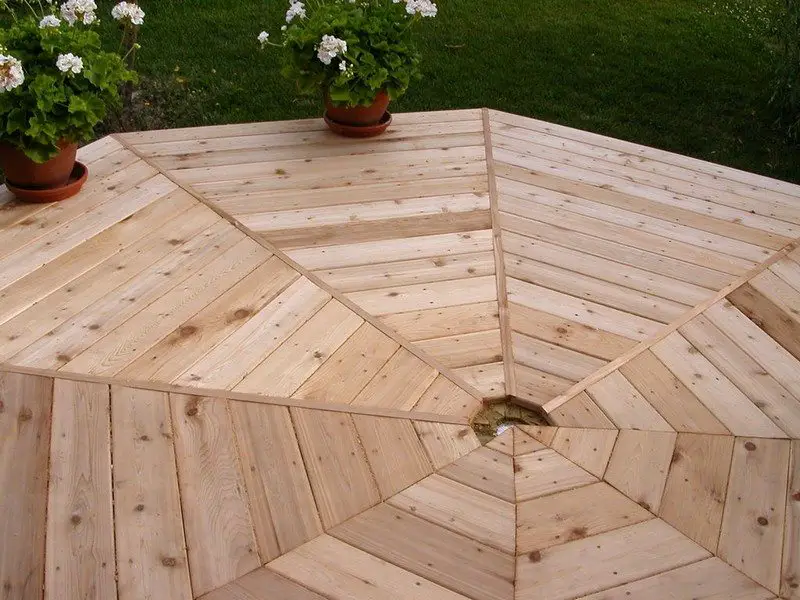
Inlays completed: This shows four inlays in place.
It doesn’t require a genius to see the improvement of the design with the inlays. The lines at the main joists are dead straight, the triangular features of the octagon pop right out.
Be sure to review this whole procedure. You don’t want to glue a strip down before screwing the joints down. In this picture (aside from my wife’s geraniums) notice that I had not decided how to finish the centre. I eventually decided on a one piece cedar octagon.
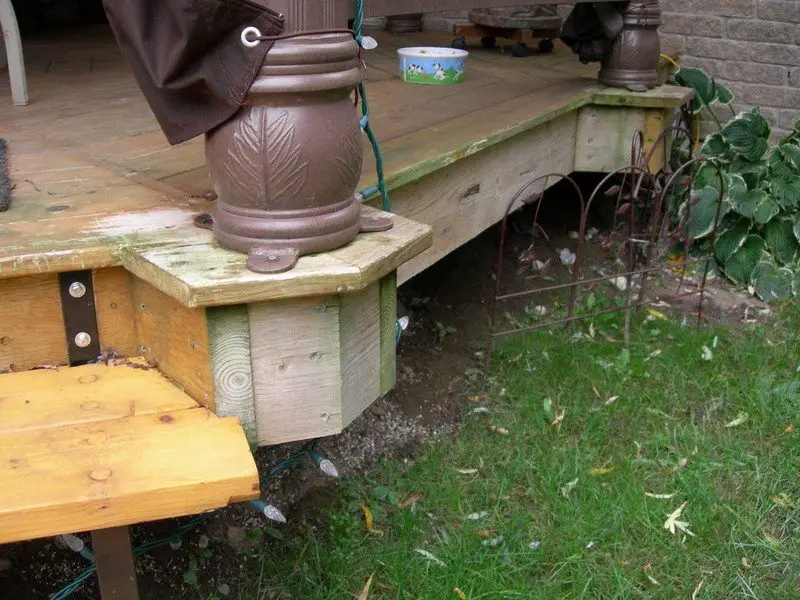
The tent mod: In our county, a hard roof on a gazebo or any deck changes all the rules. The setbacks for a deck move from 4 feet to 23 feet the minute your designs include a hard roof. The result is that I had to design for a tent roof.
This design started with the intention of cedar rails and a semi-permanent roof. Aside from the cost, the local engineering department said NO!
As it happens, my wife found a really great buy on an octagonal garden tent (about $575 Cdn.) The problem was that the outfit selling the tent had little or no documentation and were not sure of the size. They guessed 14 feet.
Does that mean 7 foot edge to edge or 7 foot radius? We bought it and found that the radius is about 13 feet 6 inches. They must include the diameter of the support poles in the 14 feet. Regardless here is where the last design mod is described.
I couldn’t increase the current radius, but I could put in extensions to the vertices to support the tent poles.Each post support is constructed of 4 pieces of wood.
Two sides at 8 inches, cutting both ends at 22.5 degrees, and two centre pieces at 4″, again with 22.5 degree cut both ends.
Assemble as shown here, glue and screw and mount at each vetrice below deck level. Fasten deck planks following the pattern of the deck with a 1-1/2 inch overhang.
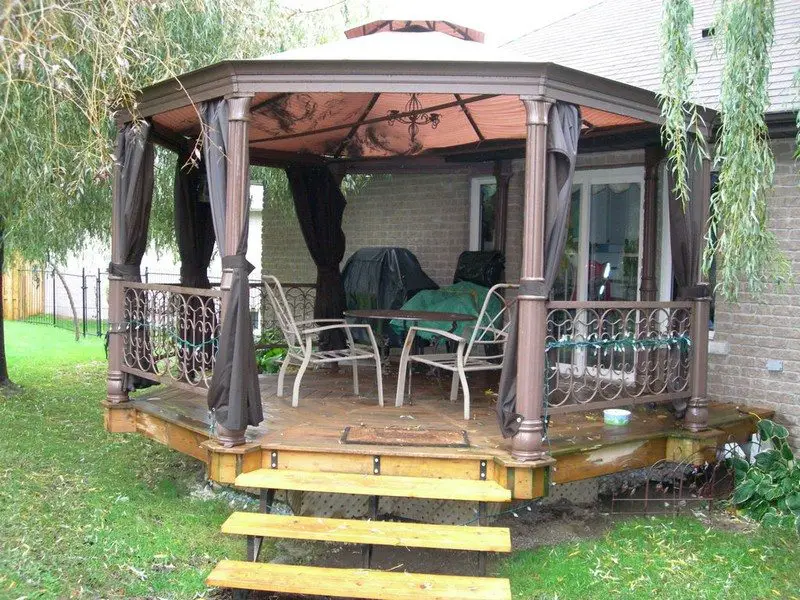
The end: That’s it guys. I am not going to talk about the stairs, we all have been there.
A couple of things:
- I sanded and refinished the deck in 2009. I probably will do it again in 2012.
- The reason for pushing the deck planks tight together came from my local lumber yard person who noted that shrinkage will occur regardless, but less with cedar than PT. His opinion has been vindicated since very little shrinkage has occurred. My fence pressure treated fence planks have shrunk about 1/2 inch in width in the last 6 years.
- The deck has been very sturdy, even when a full band with instruments has been playing on it, no shaking or bouncing. (good lattice.)
Thanks to cobourgdave for this great tutorial!
Wrapping It Up
Building an octagonal deck is a fun and rewarding way to add something special to your outdoor space. It’s not just a deck—it’s a cozy spot to relax, a cool place to entertain, and a unique feature that stands out.
With some basic tools, the right materials, and a bit of effort, you can create a backyard space you’ll love for years to come.
So, what are you waiting for? Start planning your octagonal deck today and make your outdoor dreams a reality. And while you’re at it, check out our glider swing project for even more ways to make your yard awesome!

